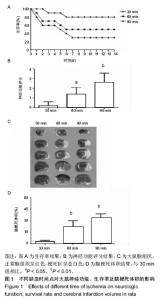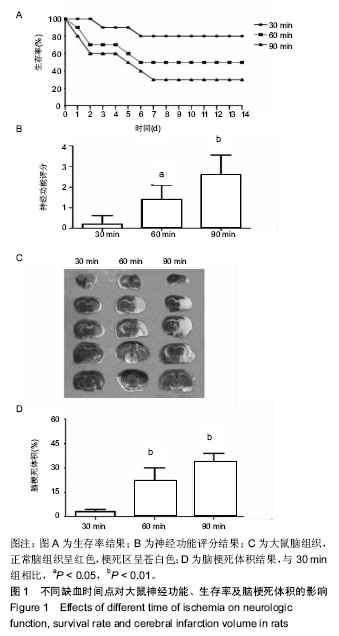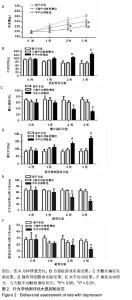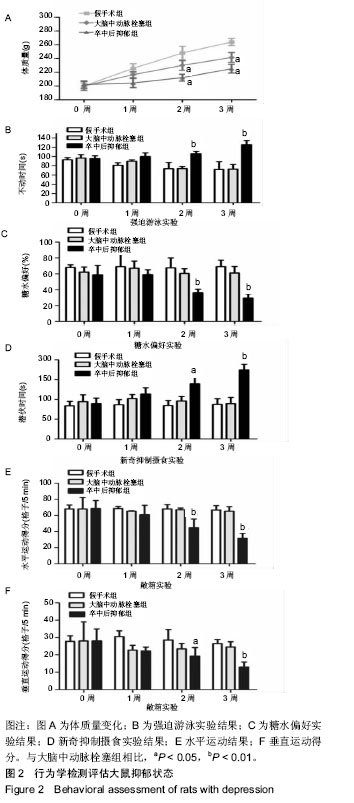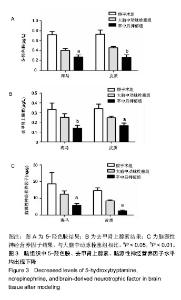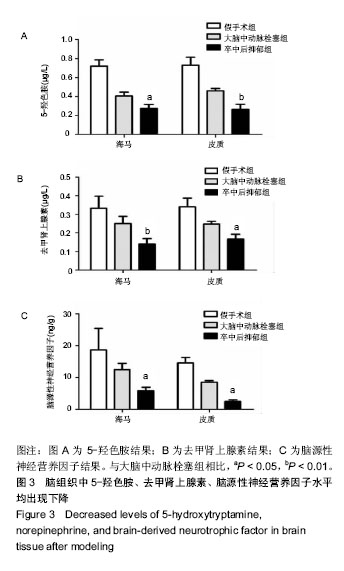| [1] Wei C, Zhang F, Chen L, et al. Factors associated with post-stroke depression and fatigue: lesion location and coping styles. J Neurol.2016;263(2):269-276.[2] Howells DW, Porritt MJ, Rewell SS, et al. Different strokes for different folks: the rich diversity of animal models of focal cerebral ischemia. J Cereb Blood Flow Metab. 2010;30(8): 1412-1431.[3] Sehara Y, Inaba T, Urabe T, et al. Survivin Overexpression via Adeno-Associated Virus Vector Rh10 Ameliorates Ischemic Damage after Middle Cerebral Artery Occlusion in Rats. Eur J Neurosci. 2018 Sep 25. [4] Yan Y, Fan W, Liu L, et al. The effects of Xingnao Jieyu capsules on post-stroke depression are similar to those of fluoxetine. Neural Regen Res.2013;(19):1765-1772.[5] Yan Y, Li T, Liu L, et al. Effect of tonifying liver and kidney-essence herbs on expression of Nogo-A and p75(NTR) in cerebral ischemic stroke rats model. J Tradit Chin Med. 2012;32(4):664-668.[6] 范文涛,闫咏梅,别玉龙,等.脑卒中后抑郁症患者肠道菌群的多样性分析[J].南方医科大学学报,2016,36(10):1305-1311.[7] 范文涛,闫咏梅,别玉龙,等.大鼠卒中后肠道菌群紊乱与抑郁的关系[J].中国脑血管病杂志, 2016(12):644-649.[8] 张慧,闫咏梅,谢福恒,等. 醒脑解郁胶囊干预卒中后抑郁及与NEI网络关系的临床研究[J]. 现代中医药, 2016;36(4):46-48.[9] Longa EZ, Weinstein PR, Carlson S, et al. Reversible middle cerebral artery occlusion without craniectomy in rats. Stroke. 1989;20(1):84-91.[10] Qi X, Hosoi T, Okuma Y, et al. Sodium 4-phenylbutyrate protects against cerebral ischemic injury. Mol Pharmacol. 2004;66(4):899-908.[11] 常晓波,王舒,樊小农,等.脑梗死大鼠模型神经功能缺损评分的动态变化分析[J]. 中华中医药杂志, 2015,30(11):4053-4056.[12] Willner P, Towell A, Sampson D, et al. Reduction of sucrose preference by chronic unpredictable mild stress, and its restoration by a tricyclic antidepressant. Psychopharmacology (Berl).1987;93(3):358-364.[13] Gaur V, Kumar A. Behavioral, biochemical and cellular correlates in the protective effect of sertraline against transient global ischemia induced behavioral despair: possible involvement of nitric oxide-cyclic guanosine monophosphate study pathway. Brain Res Bull.2010;82(1-2): 57-64.[14] Yan B, Wang DY, Xing DM, et al. The antidepressant effect of ethanol extract of radix puerariae in mice exposed to cerebral ischemia reperfusion. Pharmacol Biochem Behav.2004;78(2): 319-325.[15] Zhang G, Chen L, Yang L, et al. Combined use of spatial restraint stress and middle cerebral artery occlusion is a novel model of post-stroke depression in mice. Sci Rep.2015; 5:16751.[16] Luo L, Deng S, Yi J, et al. Buyang Huanwu Decoction Ameliorates Poststroke Depression via Promoting Neurotrophic Pathway Mediated Neuroprotection and Neurogenesis. Evid Based Complement Alternat Med. 2017; 2017:4072658.[17] de Oliveira GS, Cereser KM, Fernandes BS, et al. Decreased brain-derived neurotrophic factor in medicated and drug-free bipolar patients. J Psychiatr Res. 2009;43(14):1171-1174.[18] Pinnock SB, Herbert J. Brain-derived neurotropic factor and neurogenesis in the adult rat dentate gyrus: interactions with corticosterone. Eur J Neurosci. 2008;27(10):2493-2500.[19] Boyko M, Kutz R, Gruenbaum BF, et al. The influence of aging on poststroke depression using a rat model via middle cerebral artery occlusion. Cogn Affect Behav Neurosci.2013; 13(4):847-859.[20] Ji XW, Wu CL, Wang XC, et al. Monoamine neurotransmitters and fibroblast growth factor-2 in the brains of rats with post-stroke depression. Exp Ther Med. 2014;8(1):159-164.[21] Yan HC,Cao X,Das M, et al. Behavioral animal models of depression. Neurosci Bull. 2010;26(4):327-337.[22] Abelaira HM, Reus GZ, Quevedo J. Animal models as tools to study the pathophysiology of depression. Rev Bras Psiquiatr. 2013;35 Suppl 2:S112-S120.[23] Nestler EJ, Hyman SE. Animal models of neuropsychiatric disorders. Nat Neurosci. 2010;13(10):1161-1169.[24] Astrom M, Adolfsson R, Asplund K. Major depression in stroke patients. A 3-year longitudinal study. Stroke. 1993; 24(7): 976-982.[25] Ren L, Qian X, Zhai L, et al. Loss of Ahi1 impairs neurotransmitter release and causes depressive behaviors in mice. PLoS One.2014;9(4):e93640. [26] Lin R, Li X, Liu W, et al. Electro-acupuncture ameliorates cognitive impairment via improvement of brain-derived neurotropic factor-mediated hippocampal synaptic plasticity in cerebral ischemia-reperfusion injured rats. Exp Ther Med. 2017;14(3):2373-2379. |
